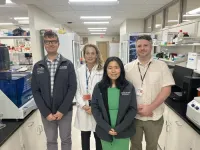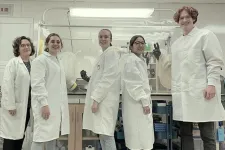(Press-News.org) Studies by researchers at UTHealth Houston seeking to understand the underlying pathology of Alzheimer’s disease in order to discover new pathways to treatment have earned multiple awards totaling $3.5 million from the Texas Alzheimer’s Research and Care Consortium (TARCC).
A state-funded organization composed of 11 medical schools across the state, the goal of the TARCC is to fund Alzheimer’s-related projects within the member institutions and promote collaborative efforts. Rodrigo Morales, PhD, professor of neurology with McGovern Medical School at UTHealth Houston, is vice chair of the TARCC Steering Committee.
Projects include the following UTHealth Houston faculty and fellows.
Andrey Tsvetkov, PhD, associate professor in the Department of Neurology: Until recently, the contribution of chromosomal sex to sex-associated differences in Alzheimer’s disease has been largely ignored. As females possess two X chromosomes, many genes that partially escape X inactivation could be expressed at higher levels in females. The ACSL4 gene is located on the X chromosome. Whether ACSL4 plays a role in Alzheimer’s disease has not been studied. The primary objective is to investigate whether ACSL4-dependent molecular mechanisms exhibit sexual dimorphism in healthy and Alzheimer’s disease-derived neurons and mouse models of Alzheimer’s disease. Since clinical research has demonstrated variable efficacy of therapeutic agents in male and female patients, identifying sex-specific mechanisms has significant translational relevance.
Tatiana Barichello, PhD, associate professor in the Louis A. Faillace, MD, Department of Psychiatry and Behavioral Sciences: Delirium is a severe neuropsychiatric syndrome characterized by sudden confusion, attention deficits, and changes in sleep and psychomotor activity. This project explores whether delirium, caused either by infection or sterile surgery, contributes to Alzheimer’s disease progression by promoting gut dysbiosis (imbalanced gut bacteria) and neuroinflammation. The first aim explores how delirium-like states, induced by infection, or by surgery without infection, affect the brain’s amyloidosis and tangles (hallmarks of the disease). The second aim focuses on how delirium affects existing disease pathology. Through this study, we aim to clarify the link between delirium and Alzheimer’s disease, potentially paving the way for improved prevention and treatment strategies for those at risk.
Rodney M. Ritzel, PhD, assistant professor in the Department of Neurology:
Women with Alzheimer’s disease exhibit greater cognitive vulnerability, faster cognitive decline, and increased brain volume loss compared to men. The hormonal shifts during menopause may elevate the risk of disease-related brain changes, as early menopause is associated with a higher risk of dementia later in life. The initiation of amyloid β (Aβ) pathology aligns with this unique life transition in women. As the primary drivers of inflammaging in the brain, senescent microglia represent important therapeutic targets, which if left unchecked, could worsen Alzheimer’s disease progression. This proposal will explore the role of biological aging in the pathogenesis and progression of Alzheimer’s disease and as a potential driver of sexually dimorphic outcomes. We will determine if the accumulation of senescent cells precedes amyloidopathy, or vice versa, and whether males and females respond similarly to senolytic treatment.
Natalia Pessoa Rocha, PharmD, PhD, MSc, assistant professor in the Department of Neurology: One of the main challenges in the field of Alzheimer’s disease and related dementias is the absence of a noninvasive, early, and reliable way to diagnose the disease in a clinical setting. While cognitive symptoms are the primary clinical features, neuropsychiatric symptoms are very common and often appear in the early stages. As a result, mild behavioral impairment has been suggested as a diagnostic category to identify patients at a higher risk of developing dementia. The major goal of this project is to contribute to validating mild behavioral impairment in a neurobiological framework using innovative and sensitive biochemical tests capable of identifying early Alzheimer’s disease-related pathology in patients with mild behavioral impairment. Validating mild behavioral impairment as a prodromal phase of Alzheimer’s disease on a biological level could pave the way for earlier clinical identification and targeted interventions for patients in the very early stages.
Salvatore Saieva, PhD, postdoctoral research fellow in the Department of Neurology: Alzheimer’s disease pathology is mainly linked to cerebral nervous system alterations, yet compelling evidence shows the contribution of peripheral tissues in disease progression. Aβ deposits have been identified in peripheral tissues of patients, including skin, liver, and intestine, and Aβ seeds can accelerate Aβ brain deposition in mouse models when challenged through different peripheral routes of administration. Notably, our group recently demonstrated that the most efficient peripheral administration route of Aβ seeds is through eye drops. This information is suggestive of an active cross-talk between brain and eyes in the context of Alzheimer’s disease. Therefore, investigating the biochemical, functional, and pathological properties of ocular Aβ deposits may be relevant to understand the mechanisms underlying disease onset and progression.
Vijayasree V. Giridharan, PhD, MPharm, assistant professor in the Faillace Department of Psychiatry and Behavioral Sciences: Recent studies suggest that the innate immune system, particularly a group of cells called innate lymphoid cells (ILCs), can revitalize the aging brain and alleviate cognitive decline. Specifically, a subtype known as ILC2 has been shown to reduce brain inflammation and improve memory in animal models by releasing protective molecules. Our preliminary research indicates that inactive ILC2 cells accumulate in the blood-brain barrier during infection, contributing to memory decline. While ILC2’s impact on memory has been studied, its role in the development of amyloid plaques and tau tangles, the two major hallmarks of Alzheimer’s disease, remains unexplored. We hypothesize that harnessing ILC2 cells could enhance memory, mitigate harmful brain changes, and slow the progression of Alzheimer’s disease. Our findings could provide valuable insights into potential immune therapies for Alzheimer’s disease and related dementias.
Huihui Fan, MBBS, PhD, assistant professor in the Department of Neurology: As the population of older adults grows around the world, the incidence of Alzheimer’s disease is also intensifying. However, not all people older than 65 are affected equally. Compared to other ethnic groups, Latinos are about 1.5 times more likely than non-Hispanic whites to develop Alzheimer’s disease and other dementias and are projected to have the steepest increase in Alzheimer’s disease in the next few decades. Some of the known and suspected risk factors for Alzheimer’s disease, for example advanced age and vascular disease risk factors such as diabetes and hypertension, predominantly present in Latinos, and may lead to their greater risks. The TARCC cohort will be used to uncover novel peripheral DNA methylation biomarkers in Hispanic patients with mild cognitive impairment and Alzheimer’s disease.
Youngran Kim, PhD, assistant professor with UTHealth Houston School of Public Health: This study looks at how the first drug approved by the U.S. Food and Drug Administration for treating agitation in Alzheimer’s patients, called brexpiprazole, is affecting Medicare patients in Texas. Before this drug was approved, doctors often used other antipsychotics that weren’t officially approved for treating agitation in dementia patients. Now that brexpiprazole is approved, the study will seek to see if its use will increase, how it might change the way doctors treat patients, and what this means for both health care costs and patient outcomes. To do this, Medicare claims data from Texas will be examined.
Sithara Thomas, PhD, postdoctoral research fellow in the Vivian L. Smith Department of Neurosurgery: Traditionally, Alzheimer’s disease research has primarily focused on neuronal and glial dysfunctions. However, recent studies suggest that brain vascular factors play a significant role in the development and progression of the disease. While it is clear that vascular decline is associated with Alzheimer’s disease, it remains unclear whether this decline is a cause or a consequence of the disease. Additionally, the potential benefits of enhancing vascular functions in ameliorating disease pathology are still being investigated. By gaining a deeper understanding of the vascular role in Alzheimer’s disease, researchers may be able to overcome the limitations of current treatments by developing medications that target and rejuvenate vascular functions.
Keran Ma, PhD, assistant professor in the Department of Neurobiology and Anatomy: Alzheimer’s disease causes abnormal function of nerve cells (neurons) in the brain, which results in cognitive impairment. Interestingly, immune cells in the brain (microglia) are capable of modulating the activity of neurons. Studies that identify changes in the genome of Alzheimer’s disease patients implicated microglia as an important cellular culprit in the disease. One variation of a microglial gene found in patients, called TREM2, increases the risk of developing the disease. The hypothesis is that TREM2 gene variation alters microglia function, which in turn causes abnormal regulation of neuronal activity by microglia. The resulting erratic activity of neurons may then impair learning and memory and induce seizures. To test the hypothesis, researchers will compare neuron-microglia communication and neuronal function between healthy control mice and genetically altered mice with Alzheimer’s disease-like brain pathology and the Alzheimer’s disease TREM2 gene variant. The outcomes of this study will help to illuminate the mechanisms driving the miscommunication between neurons and microglia and the resulting effects on brain function and memory loss, which may help to identify new avenues of Alzheimer’s disease therapeutic intervention.
Vijay Kumar M.J. Rao, MSc, PhD, postdoctoral fellow in the Department of Neurology: Unhealthy brain aging causes loss of memory, thinking skills, and the ability to perform simple daily tasks. These problems are caused by the changes in the DNA and RNA leading to their damage during aging. Various forms of DNA have been found, such as four-stranded DNA which is called G4-DNA. Similar structures are also present in RNA and called G4-RNA. These G4-DNA/RNA structures have recently been described and perform many functions inside the cells. However, the exact function of these G4-DNA/RNA structures in brain aging is not known. In a previous study, researchers at UTHealth Houston identified more G4-DNA/RNA structures in the brain cells of aged animals. The abnormal presence of these G4 structures causes severe damage to cells in the brain. This will reduce the blood supply and nutrients and kill the brain cells. Reducing these G4-DNA/RNA structures inside the neurons and astrocytes could slow the aging process and prevent the brain cells from dying. In this study, researchers will decrease the levels of these G4 structures inside the brain cells with a goal of designing new drugs to fight brain diseases.
The TARCC 2025 Scientific Symposium will be held Thursday, Jan. 23, 2025, in Austin, Texas. More information can be found here: https://ais.swmed.edu/redcap/surveys/?s=4DNFCKE3XXMYFTN8.
END
Grants for $3.5M from TARCC fund new Alzheimer’s disease research at UTHealth Houston
2024-09-19
ELSE PRESS RELEASES FROM THIS DATE:
UTIA researchers win grant for automation technology for nursery industry
2024-09-19
University of Tennessee Extension and UT AgResearch scientists have been awarded part of a nearly $10 million grant from the U.S. Department of Agriculture to study ways to use automation and robotics to address the labor shortage in the nursery crops industry.
Growing plants in a nursery is highly dependent on manual labor, making this industry particularly prone to worker shortages. An increasingly scarce workforce is limiting production, economic development and prosperity in the rural communicates where nurseries ...
Can captive tigers be part of the effort to save wild populations?
2024-09-19
Captive tigers in the United States outnumber those living in the wild. The World Wildlife Federation estimates around 5,000 of the big cats reside in the U.S., mostly owned by private citizens.
The health of this population is a genetic mystery for conservation groups and researchers interested in how the captive tigers could help stabilize or restore wild tiger populations. Are the privately owned animals just like tigers in the wild, or do they reflect characteristics popular in the illegal trade? Are they a hodgepodge of wild tiger ancestry, ...
The Ocean Corporation collaborates with UTHealth Houston on Space Medicine Fellowship program
2024-09-19
UTHealth Houston and The Ocean Corporation are collaborating on UTHealth Houston’s Space Medicine Training Fellowship program, which now includes a two-week intensive training focused on hyperbaric technologies and analog environments akin to those astronauts experience during extravehicular activities (EVAs), or space walks.
The training will enhance the hands-on learning experience of fellows in the Space Medicine Fellowship program, giving them a deeper understanding of physiological and medical challenges encountered in extreme environments.
“Integrating ...
Mysteries of the bizarre ‘pseudogap’ in quantum physics finally untangled
2024-09-19
By cleverly applying a computational technique, scientists have made a breakthrough in understanding the ‘pseudogap,’ a long-standing puzzle in quantum physics with close ties to superconductivity. The discovery, presented in the September 20 issue of Science, will help scientists in their quest for room-temperature superconductivity, a holy grail of condensed matter physics that would enable lossless power transmission, faster MRI machines and superfast levitating trains.
Certain materials involving copper and oxygen display superconductivity (where electricity flows without resistance) at relatively high — but still frigid — temperatures below ...
Study: Proteins in tooth enamel offer window into human wellness
2024-09-19
A new way of looking at tooth enamel could give scientists a path to deeper understanding of the health of human populations, from the ancient to the modern.
The method, published this week in the Journal of Archaeological Science, examines two immune proteins found embedded in human tooth enamel: immunoglobulin G, an antibody that fights infection, and C-reactive protein, which is present during inflammation in the body.
“These proteins are present in tooth enamel, and they are something we can use to study the ...
New cancer cachexia treatment boosts weight gain and patient activity
2024-09-19
Researchers discovered a drug that safely and effectively helped cancer patients when they suffered from cachexia (ku-KEK-see-uh), a common condition related to cancer that involves weight loss and muscle wasting.
The results of the randomized phase 2 clinical trial, which included187 individuals who experienced cachexia with lung, pancreatic, or colorectal cancer, were reported in the New England Journal of Medicine on Sept. 14, 2024. Richard Dunne, MD, MS, a Wilmot Cancer Institute oncologist and cachexia expert was part of the large group of investigators ...
Rensselaer researcher receives $3 million grant to explore gut health
2024-09-19
Blanca Barquera's investigation into the energy-generating processes of Bacteroides, the most abundant member of the gut microbiome, and their impact on our well-being holds the promise of significant advancements in human health. Barquera is a professor at Rensselaer Polytechnic Institute in the Departments of Biological Sciences and Chemistry and Chemical Biology.
In recent years, it has become increasingly clear that an unhealthy gut is more than just a source of digestive troubles. A healthy ...
Elam named as a Fellow of the Electrochemical Society
2024-09-19
Jeffrey Elam, senior chemist, Distinguished Fellow, and founder of the atomic layer deposition (ALD) research program at the U.S. Department of Energy’s Argonne National Laboratory, was named as a fellow of the Electrochemical Society (ECS), which focuses on advancing theory and practice at the forefront of electrochemical and solid-state science and technology. Elam, who has been with the lab since 2002, has been a trailblazer in thin film coating science and technology for over 20 years, ...
Study reveals gaps in access to long-term contraceptive supplies
2024-09-19
Oregon Health & Science University researchers have found that despite legislation in 19 states requiring insurers to cover a 12-month supply of contraception, patients aren’t receiving a year’s worth of their prescription; most receive just three months or less.
Their study recently published in the journal JAMA Health Forum shows that policies requiring coverage of a 12-month supply of short-acting hormonal contraception — most commonly the birth control pill — have not been fully implemented, resulting in no substantial increases nationally in year-long prescription orders. This leaves many patients at an increased risk for unintended ...
Shining a light on the roots of plant “intelligence”
2024-09-19
All living organisms emit a low level of light radiation, but the origin and function of these 'biophotons' are not yet fully understood. An international team of physicists, funded by the Foundational Questions Institute, FQxI, has proposed a new approach for investigating this phenomenon based on statistical analyses of this emission. Their aim is to test whether biophotons can play a role in the transport of information within and between living organisms, and whether monitoring biophotons could contribute to the development of medical techniques for the early diagnosis of various diseases. Their analyses of the measurements of the faint glow emitted by lentil ...






